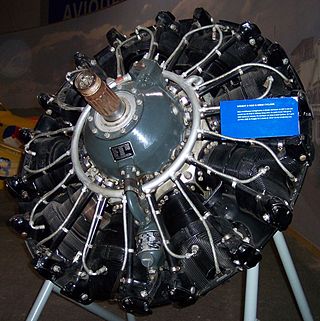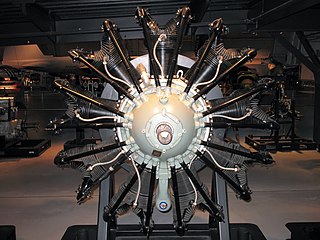
The Douglas DC-3 is a propeller-driven airliner manufactured by Douglas Aircraft Company, which had a lasting effect on the airline industry in the 1930s to 1940s and World War II. It was developed as a larger, improved 14-bed sleeper version of the Douglas DC-2. It is a low-wing metal monoplane with conventional landing gear, powered by two radial piston engines of 1,000–1,200 hp (750–890 kW). Although the DC-3s originally built for civil service had the Wright R-1820 Cyclone, later civilian DC-3s used the Pratt & Whitney R-1830 Twin Wasp engine. The DC-3 has a cruising speed of 207 mph (333 km/h), a capacity of 21 to 32 passengers or 6,000 lbs (2,700 kg) of cargo, and a range of 1,500 mi (2,400 km), and can operate from short runways.

The Lockheed Model 18 Lodestar is an American passenger transport aircraft of the World War II era, developed as part of the Model 10 Electra family, specifically from the Lockheed Model 14 Super Electra.

The Wright R-1820 Cyclone 9 is an American radial engine developed by Curtiss-Wright, widely used on aircraft in the 1930s through 1950s. It was produced under license in France as the Hispano-Suiza 9V or Hispano-Wright 9V, and in the Soviet Union as the Shvetsov M-25.

The Pratt & Whitney R-1690 Hornet was a widely used American aircraft engine. Developed by Pratt & Whitney, 2,944 were produced from 1926 through 1942. It first flew in 1927. It was a single-row, 9-cylinder air-cooled radial design. Displacement was 1,690 cubic inches. It was built under license in Italy as the Fiat A.59. In Germany, the BMW 132 was a developed version of this engine. The R-1860 Hornet B was an enlarged version produced from 1929.

The Bellanca CH-300 Pacemaker was a six-seat utility aircraft, built primarily in the United States in the 1920s and 1930s. It was a development of the Bellanca CH-200, fitted with a more powerful engine and, like the CH-200, soon became renowned for its long-distance endurance.

The Bellanca 31-40 Senior Pacemaker and its derivatives were a family of a six- and eight-seat utility aircraft built in the United States in the late 1930s. They were the final revision of the original late 1920s Wright-Bellanca WB-2 design. The model numbers used by Bellanca in this period reflected the wing area and engine horsepower, each divided by ten. Like their predecessors, these were high-wing braced monoplanes with conventional tailwheel undercarriage.

The Naval Aircraft Factory PN was a series of open cockpit American flying boats of the 1920s and 1930s. A development of the Felixstowe F5L flying boat of the World War I, variants of the PN were built for the United States Navy by Douglas, Keystone and Martin.

The Consolidated Model 17 Fleetster was a 1920s American light transport monoplane aircraft built by the Consolidated Aircraft Corporation. There was several closely related types the Model 17, Model 18, Model 20; then the C-11, C-22, and XBY military versions.

The Keystone LB-6 and LB-7 were 1920s American light bombers, built by the Keystone Aircraft company for the United States Army Air Corps, called Panther by the company, but adoption of the name was rejected by the U.S. Army.

The Fokker F-14 was an American seven/nine passenger transport aircraft designed by Fokker and built by their Atlantic Aircraft factory in New Jersey.

The Fairchild 91,, was a single-engine eight-passenger flying boat airliner developed in the United States in the mid-1930s.

The Fairchild Super 71 was a Canadian parasol-mounted high-wing monoplane cargo aircraft built by Fairchild Aircraft Ltd. (Canada). The Super 71 was an entirely new design that was one of the first purpose-built civilian bush planes for use in remote and northern locales in Canada.

The Bach Air Yacht was a trimotor airliner produced in the United States in the 1920s. Typical of its day, it was a high-wing braced monoplane, with fixed tailwheel undercarriage. Unusual for airliners of the late 1920s, the Air Yachts were constructed almost entirely of wood with steel fittings, undercarriage, and struts. Different models were powered by varying combinations of Wright, Ryan-Siemens, Kinner, Comet, and Pratt & Whitney engines, a large engine in the nose of the aircraft, and two smaller "helpers" under the wings in nacelles supported by struts. As with so many aircraft companies of the late 1920s, the Bach Aircraft Company succumbed to the Great Depression, thus further development of the Air Yacht was abandoned after the 3-CT-9.

The Northrop Delta was an American single-engined passenger transport aircraft of the 1930s. Closely related to Northrop's Gamma mail plane, 13 were produced by the Northrop Corporation, followed by 19 aircraft built under license by Canadian Vickers Limited.

The Fairchild 100 Pilgrim is an American single-engined high-wing monoplane transport, and was one of a series of single-engine utility transports built by Fairchild Aircraft.

The Pratt & Whitney R-1860 Hornet B was a relatively uncommon aircraft engine. It was a development of Pratt & Whitney's earlier R-1690 Hornet and was basically similar, but enlarged in capacity from 1,690 to 1,860 cubic inches (30.5 L). Cylinder bore was increased by 1/8" and the crankshaft stroke by 3/8". Both engines were air-cooled radial engines, with a single row of nine cylinders.

The Hamilton H-45 and H-47 were six-passenger-seat, all-metal, high-wing monoplanes powered by single Pratt & Whitney radial engines. They were built for passenger and mail-carrying work in the US in the late 1920s.

The Granville Gee Bee R-6 International Super Sportster, named "Q.E.D.", and later named "Conquistador del Cielo", was the last in a series of racing and touring monoplane aircraft from the Granville Brothers. The R-6H was dogged with bad luck throughout its career and never finished any race it entered.
The C-8 Eightster was a single-engine airliner developed by Granville Brothers Aircraft that did not go into production.




















